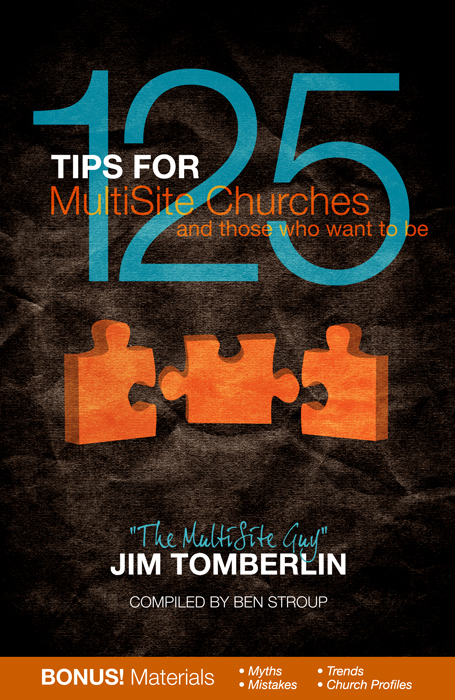Book Excerpt: 125 Tips for MultiSite Churches. Pt 1
 Introduction:
Introduction:
Going MultiSite is not for every church. It will not turn around a sick or dying church, but it can be an instrument to extend a healthy one. MultiSite is not a growth engine, but it can be a vehicle for a growing church. MultiSite is not a fad to jump on, but it has become a proven strategy to reproduce healthy, fruitful, growing churches. What began as a “Band-Aid” in the late 1990s for a handful of megachurches that found themselves out of room or restricted by zoning laws, the MultiSite idea quickly proved to be an effective option for any healthy, growing church regardless of size. Though over 50 percent of all megachurches have multiple campuses or video-venues, they only comprise about a third of all the MultiSite churches across America today. Church size doesn’t matter, church health does. What started as a radical idea with a few early pioneers has become the “new normal” across the national church scene. On any given Sunday more than 5 million people attend a MultiSite campus church in North America.
According to a 2010 survey conducted by Leadership Network, here are some fast facts about MultiSites:
1. MultiSite churches outnumber megachurches.
2. Two-thirds of MultiSite churches are denominational.
3. MultiSites reach more people and mobilize more volunteers.
4. One in three MultiSites added a campus through a merger.
5. One in four MultiSites have a campus in another language.
6. One in five MultiSites birthed a “grandchild” campus.
7. One in ten have an Internet campus.
8. In-person teaching is utilized more than video.
9. Average size of a church going MultiSite: 850.
10. Average size of a MultiSite campus: 361.
11. Eighty-five percent of MultiSite churches have three or fewer geographic locations.
12. Average weekend attendance of a MultiSite church: 1,300.
13. MultiSite campuses have a 90 percent success rate.
This eBook is about helping guide leaders through the decision-making and implementation process of going MultiSite. My intent is that these tips will become guideposts to help you navigate these new waters. And for those of you who have been doing MultiSite for some time now, it will serve as a refresher about the most important details as you continue to multiply the number of additional campuses your church starts, supports, and sustains. While going MultiSite can certainly be a practical, pragmatic decision, it is also one that allows us to expand our reach and multiply our ministry impact in one of the most reasonable and cost-effective ways available to church leaders today. There is nothing more exciting than to be a part of a growing, healthy church. There will be surprises along the way, but the good news is that many have already been there and are finding their MultiSite strategy to be a critical element to their Kingdom expansion strategy. May God extend your borders, multiply your impact, and enlarge your harvest. If we can help, let us know.
Pt 2 of Jim Tomberlin’s series will be released tomorrow!
Jim Tomberlin began his multisite church journey in the mid-1990s when he was the senior pastor at Woodman Valley Chapel in Colorado Springs, CO. In 2000 he went on to pioneer the multisite model at Willow Creek Community Church in Chicago. Since 2005 he has been coaching churches in developing and implementing multi-campus strategies.
As Founder and Senior Strategist of Multisite Solutions, Jim leads a seasoned team of practitioner specialists in assisting churches in maximizing their redemptive potential through intensive and insightful multisite and church merger consultation. Jim is the author of 125 Tips for Multisite Churches and co-author with Warren Bird of Better Together: Making Church Mergers Work.
Tim Cool has assisted more than 350 churches (over 4 million square feet) throughout the United States with their facility needs. He has collaborated with churches in the areas of facility needs analysis, design coordination, pre-construction coordination, construction management and lifecycle planning/facility management.
Tim is the author of the book, Successful Master Planning: More Than Pretty Pictures and Why Church Buildings Matter. Tim is married to his best friend, Lisa, and resides in Charlotte, NC with their teenage triplets.




